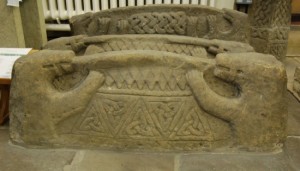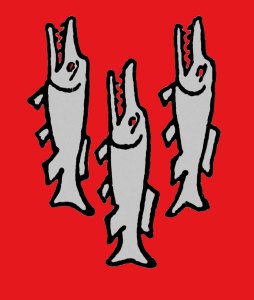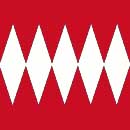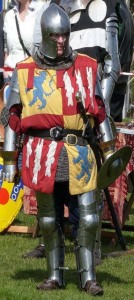
William de Percy Walter de Percy Piers de Percy Arnolde de Percy Jon de Percy Kildale Percies Nicholas de Percy
Before I discuss these Percy Blazons above take a moment to view the image below. Whilst not looking identical it does share the same heraldic elements of tinctures, fusils and fesse the hall mark of the Percies.
As mentioned by several Heraldic Authorities the Blazon to the right and those above shout out aloud the origins of the Percies and if we go further back, researchers studying ancient Viking Hogback stones have found a fascinating use of the diamond shape.
The diamond, spear, spindle or Lozenge shape appears on the stones here. It is said by one authority that they may represent roofing tiles!
The shape also appears on ancient stone runes.
Another interesting use of the shape is in the designs painted on the sails of Viking ‘Long Ships or dragon ships’ suggesting that these images represent the exposed teeth of a Snarling Dog, Dragon or Snake, used to guard the ship, painted blood red to scare the living daylights out of those whom the Vikings were about to invade!
Ancient Viking Runes exist in this shape as the foundational geometric symbol of creation meaning power.
The image on the Hogback stone to me is self explanatory. These fusil icons could easily be the origin of the ancient heraldry of the Bethune, Percy, Pennington and other Flemish Norman families that can still be found in the Heraldry of many Noble English Coats of arms to this day. Creation of Power!
Back to the Percy Blazons. The first, that of William de Percy with
the whiskers (Algernon) is described in Heraldry as – Azure, five fusils conjoined in fesse or. The others will differ in description by their tinctures.
What is very interesting is that Williams male relations used the same base but with differing colours to identify their differing families.
These arms were born by the main family through each senior male heir until the early 1300’s when Henry Percy, 8th Baron Percy, purchased Alnwick Castle and became the 1st Lord of Alnwick.
Lord Percy decided to supersede the ancient armorial of five fusils with what was known as the ‘Blue Lion Of Brabant’ on the background of Gold – Or, a lion rampant azure.
Why did he do this, one may ask? The answer in my view lies in the marriage of Lord Henry’s great great grandmother, Agnes Percy to Josceline de Louvaine in 1187 and the later marriage of Henry Earl Percy of Alnwick their great grand son.
When Henry de Percy gained Alnwick castle and the vast Northumberland estates it was the culmination of generations of Percies seeking power by gaining land.
Having Northumberland in your grip and control meant several very important things but most important was that by doing this, Henry de Percy became a virtual ‘King In The North’ with a Principality to match, right on the doorstep of Scotland, the enemy and far enough from the Crown to be able to do things that might not be approved of.
So what did Lord Henry Percy require to create the recognition to accompany his glory? A more regal Coat of Arms! So he superseded the ancient fusils of Normandy for the Blue Lion of Louvaine, the arms of his paternal ancestor Josceline of Louvain, descendant of Flemish Aristocracy brother of the Queen and direct descendant of Emperor Charlamagne.
The Percies had previously married into the family of de Brus, (who also used the lion rampant) another Norman family and it was fitting that this lineage could all be brought together under the umbrella of the Blue Lion which would set the Percy family up for the next 800 years for good or for bad.
Then in the 1360’s Lord Henry Percy’s great grand son another Henry Percy married Mary Plantagenet daughter of King Henry III and became the first Earl of Northumberland for his trouble. The Blue Lion was still rampant and Henry Percy (Hotspur) was born, a Percy was now in line to the Crown of England. Furthermore Hotspur later married Elizabeth Mortimer whose brother was the natural in line heir to King Richard II. Landowning, Marriage, Politics and Power were closely intertwined.
Then Lady Mary Percy died and The Earl Percy married Maude de Lucy the widowed heiress to the Lucy Titles, Honours and estates. Did this event change the nature of the Percy Heraldry? Yes it most certainly did. The Lucy estates were huge and this marriage meant that the Percy Family would almost double the value of their total estate which increased their landed power base exponentially and their relationship with King Richard II flourished. Maude de Lucy knew this and as part of the marriage arrangement (which included the Lucy Estates) she insisted that the armorial emblem of the Lucy family be quartered into that of the Percy Lion. This was done by Royal Decree and is documented.
This chart identifies the marks of Cadency. The Marks used by various sons in order of seniority. The Label (as seen above) for Hotspur is first then the crescent and so forth. If Hotspur had been 4th Son he would have borne the Bird.
So what happened to the heraldic use of the Percy Fusils in their livery?
They were introduced back as quarters into the Senior Percy line later on but the original fusils in fess were still being used by cadet branches of the Percy family as seen in the de Percy Family of Kildale, Yorkshire and de Percy of Bamburgh.
This photograph shows a very good example of Percy heraldry in action as worn by a Hotspur soldier at the Battle of Shrewsbury. Hotspur would have worn a similar tabbard but would have worn a blue lion on a chapeau on his helm.
Link above with lots more.
Well done Plymouth Medieval Society!
A REENACTMENT
So when did the original Five Fusils in Fess reappear?
I am presently unsure of the year that this occurred and am currently researching this.
This is an interesting rendition. Signage outside the White Swan Hotel, Bondgate Within, Alnwick.
In the meantime here are some examples of the way in which the Percy Heraldry evolved.
Here is a link to what I regard as a quality Heraldry site where you can search for various family Arms with lots of accurate and interesting background information. They also print arms onto almost anything so it’s well worth a visit. COADB














